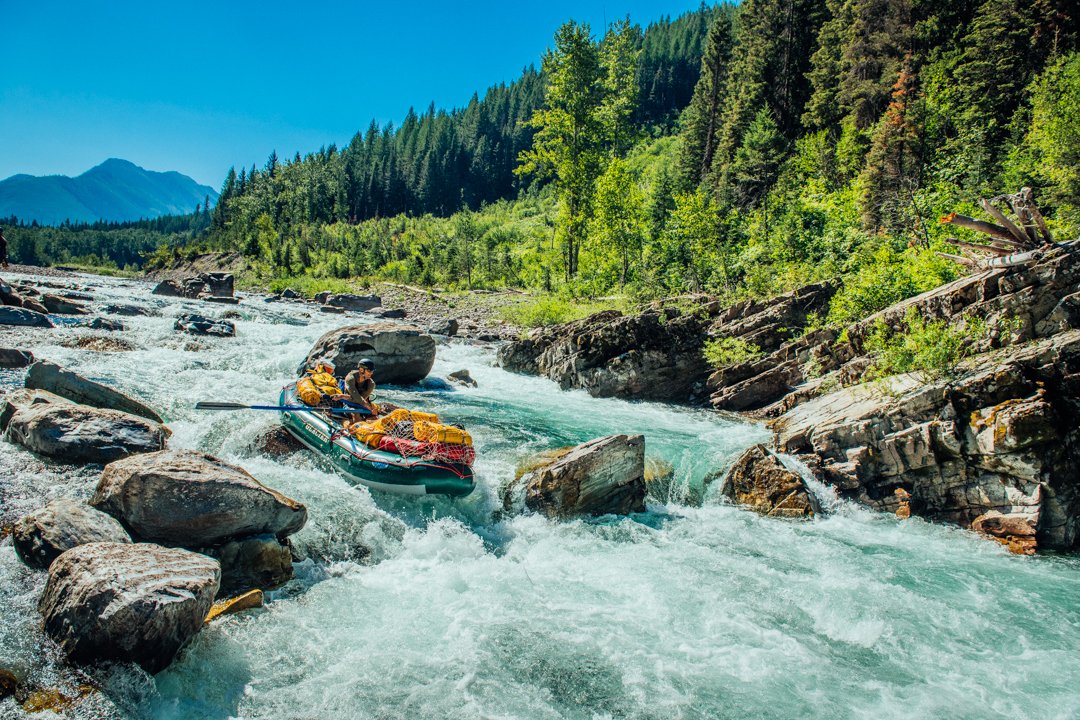
Comprehensive River Management Plan
Flathead National Forest, in coordination with Glacier National Park, has announced after some delay, planning efforts will begin again on the Comprehensive River Management Plan (CRMP) for the Three Forks of the Flathead Wild and Scenic River.
Public comment period for proposed action plan will be open for 30 days, concluding February 7, 2025 11:59:59 PM (Mountain Standard Time). Those interested in participating and submitting comments can do so through the following website: https://www.fs.usda.gov/project/flathead/?project=56536.
Public CRMP Info Sessions January 21 & 22, 2025 6:00-8:00 PM @ Flathead Valley Community College (Kalispell, MT) + Limited Virtual Option: www.flatheadrivers.org/events/comprehensive-river-management-plan-public-info-sessions-hosted-by-flathead-national-forest
Draft CRMP proposed action plan is NOW available for public review, the Forest will initiate the environmental analysis process (NEPA analysis) after public comment period for proposed action plan, which will include opportunities for additional public involvement and comment. Those interested in participating and submitting comments can expect public meetings and notification of comment periods through the following website: https://www.fs.usda.gov/project/flathead/?project=56536
Flathead Rivers Alliance will host a FAQ page here to help you navigate the process. Our goal is to help you understand the significance of the Three Forks of the Flathead and a CRMP, how to navigate the draft planning documents and the avenues with which all river users can be active participants during the public portion of the process.
Proposed action can be accessed at the Flathead Comprehensive River Management Plan project website: www.fs.usda.gov/project/?project=56536
Scoping documents: https://usfs-public.app.box.com/v/PinyonPublic/folder/158226776312
CRMP Project Background link on the Flathead NF CRMP Website includes all the materials from the 2018 Pre-scoping public engagement meetings and detailed project background: www.fs.usda.gov/detailfull/flathead/home/... and www.fs.usda.gov/detailfull/flathead/home/?cid=fseprd646335&width=full
CRMP Planning Project Milestones
Now – Scoping Period
Forest Service released proposed action plan 1/6/2025 and is gathering input on user capacity, management actions, and monitoring. Public input was originally solicited for this project in August 2019. Comments from the initial scoping period were utilized to identify public concerns and guide development of the CRMP, and a new request for public comments on the updated proposed action are being accepted with Feb. 7, 2025 deadline.
August 2025 (estimated) – NEPA Analysis
Draft CRMP and Environmental Assessment (EA) will be released for public review and comments. EA will evaluate issues, consider alternatives, and analyze effects of the proposed action and any alternatives. There will be an additional 30-day public comment period.
December 2025 (estimated) – Final Review
A Finding of No Significant Impact (FONSI) / Decision Notice (DN) will be issued, followed by a formal Objection Period.
March 2026 (estimated) – Final Plan Implementation
Comprehensive River Management Plan (CRMP) finalized and put into action.

FAQ
What is a Comprehensive River Management Plan?
Section 3(d)(1) of the Wild and Scenic Rivers Act states that “the Federal agencies charged with the administration of each component of the National Wild and Scenic Rivers System shall prepare a comprehensive river management plan (CRMP)…to provide for the protection of river values. The plan shall address resource protection, development of lands and facilities, user capacities, and other management practices necessary or desirable to achieve the purposes of this Act. The plan shall be prepared, after consultation with State and local governments and the interested public.” (https://www.rivers.gov/documents/wsr-act.pdf, pg. 3)
The Wild and Scenic Rivers Act provides specific direction; a CRMP should:
Describe the existing resource conditions including a detailed description of the Outstanding Remarkable Values (ORVs); Define the goals and desired conditions for protecting river values; Address development of lands and facilities; Address user capacities; Address water quality issues and instream flow requirements; Reflect a collaborative approach, recognizing the responsibilities of, and opportunities for, partnership with all stakeholders; Identify regulatory authorities of other governmental agencies that assist in protecting river values; and Include a monitoring strategy to maintain desired conditions. (https://www.rivers.gov/documents/management.pdf, pg 41)
Outstanding Remarkable Values (ORVs): scenic, recreational, geological, fisheries, wildlife, historic, cultural, botanical, hydrological, paleontological, scientific, and other values.
What section(s) of the Flathead River system does the Comprehensive River Management Plan cover?
The Three Forks of the Flathead River was designated a Wild and Scenic River (WSR) on October 12th, 1976 and is a component of the National Wild and Scenic Rivers System. The Flathead National Forest (the Forest) and Glacier National Park currently manage the 219 miles of the Three Forks of the Flathead River under the Flathead Wild and Scenic River Management Plan, the Flathead River Recreation Management Direction, and the current editions of the Glacier National Park General Management Plan and the Flathead National Forest’s Forest Plan (U.S. Forest Service 1980, U.S. Forest Service 1986, Glacier National Park 1999, US Forest Service 2018). (https://www.fs.usda.gov/nfs/11558/www/nepa/111973_FSPLT3_4670295.pdf, pg 5)
The Three Forks of the Flathead River includes: North, South and Middle Fork. Specifically the North Fork, from the Canadian Border to its confluence with the Middle Fork at Blankenship; the Middle Fork from its headwaters to its confluence with the South Fork; and the South Fork from its headwaters to Hungry Horse Reservoir are managed as Wild and Scenic. Further, government control will only apply to the National Forest system and National Park system lands in the river corridor. It will not apply to privately owned lands within designated river area. (https://www.rivers.gov/documents/q-a.pdf, pg 34)
Why is a new Comprehensive River Management Plan needed now?
Section 3(d) (2) of the Wild and Scenic Rivers Act requires that river management plans for WSRs designated prior to 1986 be reviewed for conformity with the Act. (https://www.rivers.gov/documents/wsr-act.pdf, pg. 3) The last river management plan for the Flathead Wild and Scenic River was approved in August 1980. An update to existing river management plan is required to comply with the National Wild and Scenic Rivers Act and reflect changes that have occurred since 1976 National Wild and Scenic River designation in forest and park management, special status species, and other laws that affect resources within the WSR corridor.
How does Flathead National Forest and Glacier National Park have authority over the river?
Rivers included in the National WSR System by act of Congress (under Section 3(a) of the Act) are administered by one of four federal agencies: BLM, NPS, USFS, and/or FWS as specified in the legislation. In the Three Forks case, the USFS is the lead agency overall, and NPS is the cooperating agency. Each agency retains its management responsibilities for the lands within corridor occurring with the Forest and Park. MT FWP retains is responsibilities for fishing and hunting regulations under state laws. (https://www.rivers.gov/documents/q-a.pdf, pg 42, 69).
Who else is involved in the management and stewardship of the Three Forks of the Flathead Wild and Scenic River?
Stakeholders and regulatory authorities involved include: local, state, federal, tribal, partners, land owners, and public.
How do Comprehensive River Management Plans affect Private Landowners along the river?
Under the Act, designation neither gives nor implies government control of private lands within the river corridor. Although many rivers include private lands within the boundaries of the designated river area, management restrictions would apply only to federal lands. The federal government has no power to regulate or zone private lands under the Act; however, administering agencies may highlight the need for amendment to local zoning (where state and local zoning occurs). People living within a river corridor may use their property as they had before designation. (https://www.rivers.gov/documents/q-a.pdf, pg. 34)
Can the public have input? What is the public engagement process?
Yes. The public will have an opportunity to comment as part of the NEPA process when the Environmental Analysis and Draft CRMP are released to the public.
Will the Comprehensive River Management Plan include permitting?
A monitoring strategy within CRMPs helps to ensure visitor use and management activities do not degrade outstanding river values. All CRMPs are required to include proposed monitoring and adaptive management plans based on indicators and standards. The proposed Desired River Conditions for the WSR are statements of aspiration that describe resource conditions, visitor experiences and opportunities, and facilities and services that the Forest Service and National Park Service strive to achieve and maintain in the WSR corridor. The proposed Desired River Conditions relate to the ORVs identified for the Flathead WSR. (https://www.fs.usda.gov/nfs/11558/www/nepa/111973_FSPLT3_4670295.pdf)
A permit system is one of several management tools indicated in CRMPs that can be used to protect and enhance the river system. Using permits is usually used as a last option. The current 1980 Flathead River Management Plan and 1986 Flathead River Recreation Management Direction issued CRMP for the Three Forks of the Flathead River includes language of permitting as a potential management tool. CRMPs identify what thresholds and standards would trigger authorization of a permit system. Managing authorities are mandated to manage National Wild and Scenic designated rivers to protect and enhance the river system from degradation of its Outstanding Remarkable Values, free-flowing condition and water quality.
What is the Three Forks of the Flathead CRMP status?
As of November 2021, prior to developing the proposed action, six public engagement sessions were held to discuss water quality, wildlife, cultural and ethnography features, fisheries, geology and botany, and recreation and scenery. The Proposed Action was then drafted and released in late summer 2019, which included a 45-day public scoping period that generated 126 written comments and included two public meetings attended by approximately 180 people. The draft CRMP and environmental assessment is expected to be released in spring of 2023 for public review and comment, including a public engagement session. The final decision and CRMP is expected to be released late summer 2022. (https://www.fs.usda.gov/detail/flathead/news-events/?cid=FSEPRD968447)
In addition, Dr. Chris Armatas, from the Aldo Leopold Wilderness Institute, conducted research following public engagement protocol and published a report of results, The Flathead Wild and Scenic River system: results from public engagement asking about human-nature relationships, threats and contributors to such relationships, and opinions about planning and management, for the Flathead River Wild and Scenic Comprehensive River Management Planning Team. (https://data.nal.usda.gov/dataset/flathead-wild-and-scenic-river-planning-2019-q-methodology-data-public-perspectives-human-and-ecological-meanings-and-services-and-drivers-change)
ADDITIONAL RESOURCES:
Scoping Cover Letter, 2019
Flathead Wild and Scenic River- Proposed Action for the Comprehensive River Management Plan (July 2019)
Flathead Comprehensive Management Plan Pre-Scoping News & Meetings Recordings & Presentations
Flathead National Forest Wild & Scenic Rivers Page
Outstandingly Remarkable Values Assessment of the Flathead River System, January 2013
River Corridor Regulation and Brochure Pages
Flathead Wild and Scenic River Management Plan, 1980
Flathead Wild and Scenic River Recreation Management Direction, 1986
Flathead Wild and Scenic River Proposal EIS, March 7, 1977
Wild and Scenic River Study Report for the Flathead River, 1975
National Wild and Scenic Rivers | www.rivers.gov |
3 Forks of the Flathead Wild & Scenic River CRMP
Flathead Comprehensive River Management Plan
Flathead Wild and Scenic River- Recreation Management Direction
Flathead National Forest Land Management Plan
A Compendium of Questions & Answers Relating to Wild & Scenic Rivers
A Public Engagement Protocol: Social Science in Support of Planning Efforts
Flathead Rivers Alliance worked collaboratively with Flathead National Forest and Glacier National Park to answer FAQs. These questions were compiled from FRA River Ambassador shifts, events, and stakeholder calls and emails.
FOR ADDITIONAL INFORMATION, CONTACT:
Flathead Rivers Alliance
Sheena Pate, Executive Director
phone: (406) 407-0421
email: info@flatheadrivers.org
Flathead National Forest
Chris Prew, Recreation Program Manager
phone: (406) 758-3538
email: Christopher.Prew@usda.gov
Glacier National Park
Kate, Wilderness and Wild Scenic River Coordinator
phone: (406) 888-7838
email: Kate_Mchugh@nps.gov
Sign Up for Flathead National Forest-Three Forks of the Flathead River CRMP Emails
https://www.fs.usda.gov/detailfull/flathead/home/?cid=fseprd573051&width=full#SignUp
Hard copies of the proposed action document are also available for review at the Hungry Horse-Glacier View Ranger Station (10 Hungry Horse Drive, Hungry Horse, MT 59919) or at the Forest Supervisor's Office (650 Wolfpack Way, Kalispell, MT 59901).

Make a donation.
At Flathead Rivers Alliance we know we can not protect this invaluable resource alone. We need your help to ensure this national treasure is safeguarded for future generations. Please consider making a donation today.
